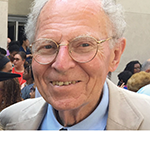Rheumatologists Named to the Association of American Physicians
Five rheumatologists were elected to the Association of American Physicians (AAP) this year in recognition of their outstanding careers and contributions to the field. The AAP, founded in 1885, is a prestigious medical professional organization with approximately 1,000 active members and 550 emeriti and honorary members worldwide.
One AAP inductee is Jane E. Salmon, MD, professor of medicine and obstetrics and gynecology at Weill Medical College in New York City and Collette Kean Research chair and co-director of the Kirkland Center for Lupus Research at the Hospital for Special Surgery in New York City. “I’m gratified that they are honoring translational research on a woman’s disease by a woman investigator,” she says. Already her research achievements have won Dr. Salmon the Nachman Prize in 2007. “[My] overall research goal is to identify determinants of disease manifestations and severity in SLE and related diseases,” Dr. Salmon explains, “and translate these discoveries to develop new targets and therapies.”
Dr. Salmon and her co-researchers have systemically pursued this goal, working with animal models to determine the mechanisms of tissue injury in these diseases. For example, based on a mouse model, Dr. Salmon’s team showed that antiphospholipid antibody-mediation pregnancy complications depend on activation of complement; this result is in contrast to the idea that antiphospholipid syndrome promotes thrombosis in this setting. Building on this work, Dr. Salmon says that she “designed and lead the multi-center PROMISSE (Predictors of pRegnancy Outcome: bioMarkers In antiphospholipid Syndrome and Systemic lupus Erythematosus) study to determine whether (and which) of these mediators predict poor fetal outcome.” Her current work continues to explore the pregnancy complications in women with rheumatic diseases.
Of her election to the AAP, she says, “I hope that the recognition by the rheumatology community that this is valuable will motivate trainees to pursue careers in basic and clinical research.”
Laurie H. Glimcher, MD, the Irene Heinz Given professor of immunology at the Harvard School of Public Health and professor of medicine at Harvard Medical School in Boston, was also elected to the AAP this year. Dr. Glimcher is currently senior rheumatologist at the Brigham and Women’s Hospital, and she heads both the immunology program at Harvard Medical School and the division of biological sciences program at the Harvard School of Public Health.
Dr. Glimcher’s research explores the molecular pathways that regulate CD4 T helper cell development and activation. In particular, Dr. Glimcher studies two key cytokines, IL-4 and IFN-γ, characterizing their transcription during differentiation. Already she and her colleagues have defined the expression of these cytokines in T cells, identified the proto-oncogene c-maf as the transcription factor responsible for Th2-specific IL-4 expression, and discovered the first TH1-specific transcription factor, T-bet. Dr. Glimcher discovered the transcription factor XBP-1, which controls plasma cell differentiation and the Unfolded Protein response. Her laboratory’s most recent accomplishment has been identifying new proteins that control osteoblast commitment and activation. This research may lead to new approaches to manipulate these processes in inflammatory and autoimmune diseases as well as cancer.
Another rheumatologist elected to the AAP this year is Paul H. Plotz, MD, chief of the Arthritis and Rheumatism Branch and chief of the Connective Tissue Diseases Section of National Institute and Musculoskeletal and Skin Diseases (NIAMS) at the National Institutes of Health (NIH) in Bethesda, Md. “It had a real resonance for me to belong to this society,” says Dr. Plotz, who enjoyed seeing many old friends among the AAP members who welcomed him.
Like many rheumatologists of his generation, Dr. Plotz focused his research the immunology that followed the discovery of autoantibodies in key rheumatologic diseases such as rheumatoid arthritis and lupus. Dr. Plotz’s current research concerns the skeletal development of children with Pompe’s disease and the effects of enzyme replacement in fast-twitch muscles. “What’s fascinating is the way [the disease] isn’t behaving the way it should,” remarks Dr. Plotz. “In this illness, the principal problem is in muscle, and the downstream consequences of missing this enzyme are very different from what they appear to be in any of the other tissues.”
Dr. Plotz expressed tremendous gratitude for the freedom the NIH allows its researchers, and attributed the success of his research to the independence he has enjoyed there for over forty years. “There is a respect of the highest order for the wishes of hired scientists. . . If you’re given a lab and a budget, no one keeps you from doing what you want to do.”
Another AAP inductee is Jill P. Buyon, MD, professor of medicine and vice chair of the division of rheumatology in the department of medicine at New York University (NYU) School of Medicine and director of the Lupus Clinic at NYU’s Hospital for Joint Diseases in New York City.
Dr. Buyon’s research has focused on autoantibody-associated congenital heart block. She identified the spectrum of heart block, defined recurrence rates in the largest cohort to date, and proposed a pathogenetic cascade which links cardiocyte death to maternal anti-Ro/La antibodies and subsequent inflammation and scarring of the fetal conduction system. Dr. Buyon also established a national NIAMS-funded registry of families affected by this disease and provided internationally adopted guidelines on the approach to management of all anti-Ro positive pregnant women.
The fifth rheumatologist named to the AAP is Mark Reid Philips, MD, professor of medicine, cell biology, and pharmacology at NYU’s Langone Medical Center. Dr. Philips’s research focuses on the cell biology of GTPases—ubiquitous elements of signaling pathways, including those regulating cell growth and differentiation—which has potential implications for a wide variety of human diseases including inflammatory and autoimmune disorders, according to his lab Web site.
This is what I really love to do, and the fact that this is the highest recognition in the entire state university system that you can get means that you’ve been recognized for something that you value and they value.
—Ellen M. Ginzler, MD, on being named Distinguished Teaching Professor by SUNY Downstate
International Carol Nachman Prize
Lars Klareskog, MD, PhD, professor at the Rheumatology Clinic and Rheumatology Research Unit of the Karolinska Institutet and Karolinska Hospital in Stockholm, Sweden, was awarded the International Carol Nachman Prize, the highest international honor for rheumatology, in Wiesbaden, Austria this year. Dr. Klareskog received this award in recognition for his work on the etiology of rheumatoid arthritis (RA). Focusing on immune system activation and regulation,his research looks closely at the influence of genes and environment on the disease.
Dr. Klareskog brought together a group of expert geneticists and epidemiologists to explore the interplay of the environment and genetics in RA. “The … major contributions mentioned in motivation for the prize were based on what we did in the eighties, that was studying a particular molecule called a transplantation antigen in its role in immune activation in RA,” he explains. “We pursued this observation by studying how environmental stimuli such as smoking interact with this transplantation antigen in giving rise to reactions that may cause RA. That means we understand how genes and the environment interact in causing the disease.” Of the impact of his research, he says, “I think we have contributed to . . . studying the process that occurs in early stages of the disease even before the onset of symptoms and. . . This may allow us to make intervention both by prevention and therapy.”
Dr. Klareskog stresses the collaborative nature of this undertaking, which has spanned a number of years. “Mainly [the Nachman Prize] is the recognition of the work of myself and the many collaborators. It’s a group that I’ve been working with for many years that has been able to produce these results. So it’s a recognition for all of us,” he says.
SUNY Downstate Distinguished Teaching Professor
SUNY Downstate has named Ellen M. Ginzler, MD, MPH, professor of medicine and chief of rheumatology there, a Distinguished Professor, its highest rank. The title has special significance to Dr. Ginzler because it was also granted to her greatest role model at the university, Dr. Hugh Carol, whom she identified as one of SUNY Downstate’s best professors 30 years ago when she began as an intern. Dr. Ginzler still admires and emulates the rigor of the 90-year-old doctor who, even in his retirement, continues to come in to work every day.
Dr. Ginzler directs the second-year musculokeletal block of courses at the university, which all medical students are required to take. She created the Patient Demonstration Sessions, which students repeatedly rated the best teaching session of the year, and started the mentoring program of the American College of Rheumatology. In addition to teaching, Dr. Ginzler reviews fellowship applications for the university’s rheumatology program. From her perspective at SUNY Downstate, there seems to be no lack of interest in the next generation of physicians. Every year, Ginzler and her colleagues assess more than 100 applications for fellowships, inviting 25 candidates for interviews before choosing two for the coveted spots.
“This is what I really love to do,” says Dr. Ginzler, “and the fact that this is the highest recognition in the entire state university system that you can get means that you’ve been recognized for something that you value and they value.”
Lucy Randall is a writer based in New Hampshire.

